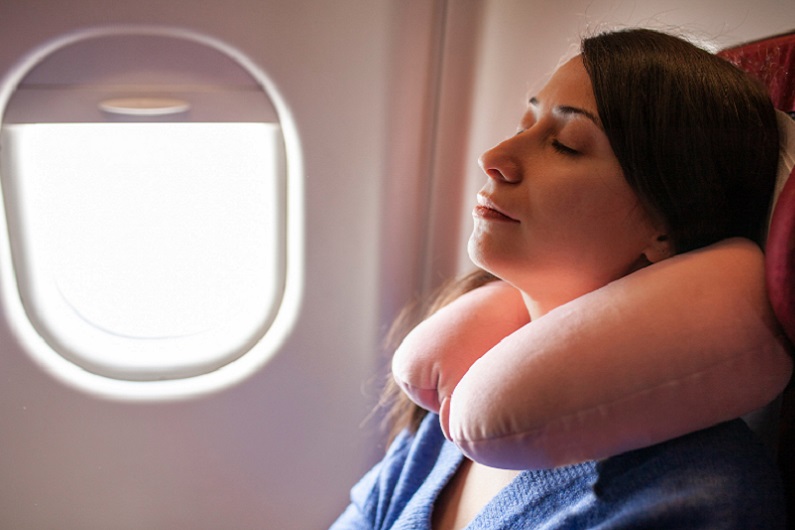You’ve taken the leap and booked your trip. The anticipation of the adventures that lie ahead fills you with excitement – envisioning awe-inspiring sights, savoring delightful new flavors, and immersing yourself in the sensory experiences of the places you’ll visit.
Yet, nestled within this excitement comes some unease about the flight.
Embarking on a long flight can feel daunting, especially for sensitive people given that we’re so attuned to our environments.
As a retreat facilitator, I’m used to lengthy travel, but even I experience some dread when it comes to long-haul flights.
Several participants from our upcoming retreats have expressed nervousness. So, I’ve put together some tips to set the stage for a more comfortable experience.
Prepare in Advance to Manage Anxiety on Long Flights
1) Pack Intentionally: Bring items that offer comfort and shield you from external stimuli. Wear comfy clothing. Airplanes can get cold, so pack cozy layers and socks. Consider packing noise-canceling headphones, ear plugs, an eye mask, and a travel pillow. Some travel pillows even have heating and massage features.
Though not a typical travel pillow, I use the Pillow Cube Sidekick. With a window seat, it sits perfectly between my neck and the wall without collapsing. It’s not small, but can be squished into a carry-on without losing its shape. This also ensures I have a good side-sleeping pillow during my travels.
If you’re sensitive to smell, masks can serve as a barrier for perfumes or other scents, as can a tiny bit of Tiger Balm under your nose (if you’re okay with this scent).
If you’re checking your luggage, be sure to pack a change of clothes and essential toiletries in your carry-on.
2) Consider a Stop-Over: If you can extend your travel by a day or two, consider a stop. Identify the major airports where flights from your city are likely to stop. See if you can book two separate flights or a flight with an extended layover. This year, I’ve booked an overnight stay in Abu Dhabi on my way to Thailand, which is actually cheaper even with hotel costs.
3) Choose the Right Seat: Paying extra to select your seat can be worth it for long flights. Window vs. aisle is a personal preference. I always opt for the window because I like being able to gaze out, lean against it, and have one side of me without a person there. However, if you’re tall, maybe you prefer the aisle (or exit row) to stretch your legs more often. Look for flights that offer a Premium Economy option. Some premium economy seats offer more seat recline, leg room, and wider arm rests.
4) Talk to Professionals: If you’re feeling highly anxious, talk to your doctor and/or therapist about ways to manage your anxiety. This might be tools and techniques or anxiety medication for the flight.
Create a Relaxing Inner & Outer Environment
1) Engage Your Senses: Curate a playlist of calming music, guided relaxation, or yoga nidra. Give yourself a massage to self-soothe (also for circulation). I pack a tennis ball to lean into for relief from chronic knotting in my upper back. Use your senses to cope with anxiety on long flights.
2) Breath Awareness: Slowing your breath, particularly your exhale, can help calm your nervous system. Exhale to the extent you can, notice the brief pause at the end of the exhale, and then, allow an easy, gentle inhale. Repeat and invite your breath to be a loving travel companion.
3) Grounding: Become aware of all the points of contact your body makes with a support beneath you and notice what is holding you. Another grounding technique is to Identify a relaxed or neutral place in your body (maybe a hand or toe) that can serve as an anchoring resource. Let your attention rest there as you breathe gently.
4) Befriend Your Anxiety: Become fully aware of your anxiety. Maybe give it a name. Acknowledge its worries with compassion, as a loving adult would to a scared child. Further, you can let this part of you know you’ve “got this” while continuing to soothe and tend to its concerns as needed.
Self-Care & Movement
1) Stay Hydrated: Dehydration can intensify feelings of anxiety and discomfort. Drink plenty of water and avoid excessive caffeine and alcohol.
2) Gentle Movement: While in your seat, you can incorporate shoulder rolls, neck movement, ankle circles, gentle twists, and arm stretches to promote circulation and relieve muscle tension.
3) Walking Breaks: Movement can help release endorphins and alleviate restlessness. Take short walks around the cabin to stretch your legs.
4) Rest: Keep in mind time changes and your circadian rhythm. Sleeping on airplanes may not be easy, but at least give yourself time to close your eyes for extended periods.
Distraction & Entertainment
1) Engage in Reading / Listening: Give yourself something to look forward to on the plane. Download new episodes of your favorite podcasts or save that book you’re dying to read.
2) Watch a Movie: Most long-haul flights feature a wide selection of films, television series, and even language lessons to help pass the time. Of course, opt for calming shows and comedies.
3) Creative Pursuits: Consider carrying a small sketchbook, coloring book, journal, or puzzles to foster relaxation and focus.
When Managing Anxiety on Long Flights, Remember This
You can prepare all the things and still encounter discomfort. However, part of what can make travel meaningful is your own choice to test your edges and strengthen your resilience. Each moment, even the journey there and away, can be a time for reflection – a time to get to know your own capacity. Remember to be kind and patient with yourself along the way.
Do you experience anxiety about flying?
Feel free to share a comment about how you manage anxiety on long flights in a comment below. Or check out the following:
Read: HSP Travel Tips: 8 Ways to Preserve Your Energy
Listen to: How Introverts Can Take the ‘Drain’ Out of Travel — and Enjoy It More







